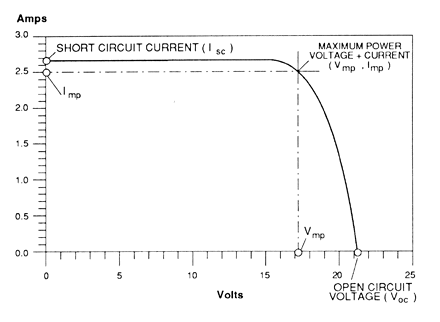

Overview — 300 Watt Pure Sine Wave Inverter300 Watt Pure Sine Wave Inverter (PST-300-12)
This high efficiency DC-AC inverter converts 12 Volts DC to 300 Watts of pure sine-wave AC power at 120 Volts, 60 Hz. The unit comes with detachable cable with 12V plug adaptor and cable with battery clamps. Features include overload protection, low battery alarm / shut down, low idle power draw. AC power is available from a NEMA-20R GFCI duplex outlet on the front panel.
Resources — 300 Watt Pure Sine Wave Inverter300 Watt Pure Sine Wave Inverter (PST-300-12)
Documents — 300 Watt Pure Sine Wave Inverter300 Watt Pure Sine Wave Inverter (PST-300-12)
📙 Product Manual 📊 Samlex Specifications (EN) 📊 Samlex Specifications (ES)Videos — 300 Watt Pure Sine Wave Inverter300 Watt Pure Sine Wave Inverter (PST-300-12)
🎬 Samlex Solar Inverter VideoWarranty — 300 Watt Pure Sine Wave Inverter300 Watt Pure Sine Wave Inverter (PST-300-12)

✓ OffGrid Harbor is an Authorized Samlex Dealer
✓ Includes all applicable Manufacturer Warranties
✓ Ships direct from manufacturer
✓ Additional Lifetime support from our specialists
Features — 300 Watt Pure Sine Wave Inverter300 Watt Pure Sine Wave Inverter (PST-300-12)
- High efficiency
- Temperature controlled cooling fan – reduces energy consumption
- Low interference Wide operating DC input range: 10.5 – 16.5 VDC
- LED indicators for power and protections
- Low idle power draw
- Dual GFCI protected AC outlets
- Commercial grade design suitable for heavy duty loads, long periods of continuous operation & for emergency back up
- UPC – Universal Protection Circuit: low voltage, over voltage, over temperature, over load and short circuit
- Detachable cable with 12V plug adapter
- Detachable cable with battery clamps
- Safety certified to UL standards, FCC compliant
- Remote Input – Turn inverter ON or OFF with ignition start or any other Remote ON/OFF switch
FAQs — 300 Watt Pure Sine Wave Inverter300 Watt Pure Sine Wave Inverter (PST-300-12)
Q: What is a DC-AC inverter?
When you plug anything into the wall in your home you are usually “plugging in” to the power-grid provided as a service by your utility company. Your utility company supplies you with alternating current (AC) electricity. AC electricity flows in alternate directions many times per second. AC is used for utility grid service because it is more practical for long distance transmission.
Batteries provide direct current electricity (DC) electricity which flows in a single direction. DC power is what is used in many electronics in the home like laptops, solar cells, LED bulbs, and electric vehicles. They usually have built-in converters to take the AC power received from a plug-in and convert it to DC.
An inverter (converter) acts as a power adapter as it converts DC to AC, AC to DC, and can also change the voltage. It allows a battery-based system to run conventional AC appliances directly or through conventional home wiring.
Q: What are the criteria for selecting the right inverter for a particular application?
To choose an inverter; you should first define your needs. Where is the inverter to be used? Inverters are available for use in buildings (including homes), for recreational vehicles, boats, and portable applications. Will it be connected to the utility grid in some way? Electrical conventions and safety standards differ for various applications, so don’t improvise.
When sizing an inverter, you need to take into consideration both the running power (continuous) and the additional starting surge power requirements of the AC side loads.
Some loads require much higher starting surge power for the first few seconds before settling down at the running power. The inverter should be sized on the basis of the starting surge power of the AC side load. The total starting surge power is equal to the normal running power plus the additional starting power. The following symbols and equation will be used for explanation purposes:
- Running Power, Watts – Wr
- Additional Starting Power or Additional Continuous Power, Watts – Wa
- Total Starting Surge Power, Watts = Running Power (Wr) + Additional Starting Power / Additional Continuous Power (Wa)
The specifications of inverters may include a rating termed Surge Power. Normally, the duration of this Surge Power rating is not quantified in the specifications and is assumed to last for less than 1 second. Unless the Surge Power Rating of the inverter is specified to last for > 5 seconds, this Surge Power specification of the inverter should not be considered for purposes of sizing loads with high and prolonged starting surge power. Only the Continuous Power rating of the inverter should be considered in such cases.
Electric motor driven compressor/pump based loads like refrigerators/freezers, air conditioners, air compressors, sump and well pumps, etc. require a very high Starting Surge Power of around 5 to 7 times the Running Power for the initial start up. This Starting Surge Power may last for 2 to 5 seconds. The Additional Starting Power Wa should be taken as 4 times the Running Power Wr.
Switched Mode Power Supplies (SMPS) that do not have Power Factor correction draw a non linear, pulsing current with a high Crest Factor (Ratio of instantaneous value and the RMS value) that may reach a value of 4. Also, the effective Power Factor of these types of power supplies is very low around 0.6. If the inverter is sized based on the Running Power of these units, the inverter will be continuously overloaded from instant to instant due to the higher peaks of the pulsing current. The inverter for these units should be sized at 3 times the Running Power of the power supply. Alternatively, for sizing purposes, the Additional Continuous Power Wa should be taken as 2 times the Running Power Wr. Consumer electronics like computers, TV, VCR, audio/ video devices, etc. use this type of power supply. (Please note that this sizing is not applicable if the SMPS has Power Factor correction and the Power Factor is around 0.9).
Motors used in washing machines have to start under load due to the weight of the clothes, water and the drum. Hence, the Additional Starting Power Wa should be taken as 2 times the Running Power Wr. This starting power normally lasts from 2 to 5 seconds.
The Watt rating of the microwaves normally indicates output cooking power in Watts. As the microwave is not an efficient device, the AC input power in Watts should be taken as 2 times the output cooking power in Watts i.e. the Additional Continuous Power Wa should be taken as 1 time the Running Power Wr. Hence, a microwave with 900 Watt cooking power will require an 1800 Watt inverter. (If the power rating of the inverter is indicated as the AC input power in Watts, the factor of 2 is not applicable).
The following symbols and equations are used in the sizing of an inverter example below:
- Total Running Power of the items selected, Watts – Wrt
- Highest Additional Starting Power out of the items selected, Watts – Wah
- *Highest power for sizing purpose, Watts – Wrt + Wah
* It is assumed that only one out of the selected items starts at one time
Since the AC loads rarely start at the same time, the load with the highest Additional Starting Power Wah has been factored in.
Example:
|
Device / Appliance |
Running Power, Wr, Watts |
Additional |
Quantity |
Extended |
|---|---|---|---|---|
Refrigerator – Electric Compressor based |
200 |
800 |
1 |
200 |
Color TV |
225 |
450 |
1 |
225 |
Laptop Adapter |
120 |
240 |
1 |
120 |
Incandescent Lamps |
60 |
0 |
6 |
360 |
* Additional Continuous Power is applicable to SMPS based loads that have no Power Factor Correction.
Total Extended Running Power, Wrt = 200 + 225 + 120 + 360 = 905 Watts
Highest Additional Starting Power, Wah = 800 Watts
Highest Power for sizing the inverter = Total Running Power, Wrt(905 W) + Highest Additional Starting Power, Wah (800 W) = 1705 Watts
To get an idea of the size of Samlex Inverter you may need, use our simplified run-time calculator today or contact us.
Q: What are the electrical standards pertaining to DC-AC inverters?
The DC input voltage must conform to that of the electrical system and battery bank. 12 volts is recommended for small, simple systems. 24 and 48 volts are the common standards for higher capacities. A higher voltage system carries less current, which makes the system wiring cheaper and easier.
The inverter’s AC output must conform to the conventional power in the region to run locally available appliances. The standard for AC utility service in North America is 120 and 240 Volts at a frequency of 60 Hertz (cycles per second). In Europe, South America, and most other places, it is 230 volts at 50 Hertz.
Q: What are "continuous" and "surge" power capacity ratings for DC-AC inverters?
How much load can an inverter handle? Its power output is rated in Watts. There are two levels of power rating -a continuous rating and a surge rating. Continuous means the amount of power the inverter can handle for an indefinite period of hours. When an inverter is rated at a certain number of Watts, that number generally refers to its continuous rating. The “surge power” indicates the power to handle instantaneous overload of a few seconds to provide the higher power required to start certain type of devices and appliances. Resistive types of loads (like incandescent lamps, toaster, coffee maker, electric range, iron etc) do not require extra power to start. Their starting power is the same as their running power.
Q: What types of electrical loads require "surge power"?
Some loads like induction motors and high inertia motor driven devices will initially require a very large starting or “surge” power to start from rest. Once they have started moving and have attained their rated speed, their power requirement reduces to their normal running power. The surge may last up to 5 seconds. TVs and microwave ovens also require surge power for starting. The manufacturers’ specification of the appliances and devices indicates only the running power required. The surge power required sometimes is unknown or is a best guess.
Q: How do "surge power" electrical loads affect DC-AC inverter operation?
If an inverter cannot efficiently feed the surge power, it may simply shut down instead of starting the device. If the inverter’s surge capacity is marginal, its output voltage will dip during the surge. This can cause a dimming of the lights in the house, and will sometimes crash a computer.
Any weakness in the battery and cabling to the inverter will further limit its ability to start a motor. A battery bank that is undersized, in poor condition, or has corroded connections, can be a weak link in the power chain. The inverter cables and the battery interconnect cables must be sized properly. The spike of DC current through these cables is many hundreds of amps at the instant of a motor starting for example.
Q: How should I size my DC-AC inverter for loads that require starting surge?
Observe the following guideline to determine the continuous wattage of the inverter for powering loads that require starting surge. (Multiply the running watts of the device/appliance by the Surge Factor)
NOTE: The surge power rating specified for this inverter is valid for duration of less than 1 second. This very short duration may not be sufficient to start motor based loads which may require up to 5 seconds to complete starting process. Hence, for purposes of sizing the inverter, use only the continuous power rating of this inverter.
|
Device / Appliance |
Surge Factor |
|---|---|
Refrigerator / Freezer |
5 |
Air Compressors |
4 |
Dishwasher |
3 |
Sump pump |
3 |
Furnace fans |
3 |
Industrial motors |
3 |
Circular saw |
3 |
Bench Grinder |
3 |
Portable diesel / kerosene fuel heater |
2 |
Q: How should I size my DC-AC inverter to operate a microwave?
The power rating of the microwave generally refers to the cooking power. The electrical power consumed by the microwave will be approximately 2 times the cooking power. The “surge power” of the inverter should be 2 times the electrical power (i.e., 4 times the cooking power). Please note that the surge power of the microwave is not as long as the motor load and hence, the surge power of the inverter can be considered to determine adequacy of meeting the starting surge power.
Q: How should I size my DC-AC inverter to power a water supply pump?
A water well or pressure pump often places the greatest demand on the inverter. It warrants special consideration. Most pumps draw a very high surge of current during start up. The inverter must have sufficient surge capacity to handle it while running any other loads that may be on. It is important to size an inverter sufficiently, especially to handle the starting surge (If the exact starting rating is not available, the starting surge can be taken as 3 times the normal running rating of the pump). Oversize it still further if you want it to start the pump without causing lights to dim or blink.
In North America, most pumps (especially submersibles) run on 240 VAC, while smaller appliances and lights use 120 VAC. To obtain 240 VAC from a 120 VAC inverter, use a 120 VAC to 240 VAC transformer. If you do not already have a pump installed, you can get a 120 volt pump if you don’t need more than 1/2 HP.
Q: What is "idle power" in a DC-AC inverter?
Idle power is the consumption of the inverter when it is on, but no loads are running. It is “wasted” power, so if you expect the inverter to be on for many hours during which there is very little load (as in most residential situations), you want this to be as low as possible.
Q: What are Phantom and idling loads?
Most of the modern gadgets draw some power whenever they are plugged in. Some of them use power to do nothing at all. An example is a TV with a remote control. Its electric eye system is on day and night, watching for your signal to turn the screen on. Every appliance with an external wall-plug transformer uses power even when the appliance is turned off. These little loads are called “phantom loads” because their power draw is unexpected, unseen, and easily forgotten.
A similar concern is “idling loads.” These are devices that must be on all the time in order to function when needed. These include smoke detectors, alarm systems, motion detector lights, fax machines, and answering machines. Central heating systems have a transformer in their thermostat circuit that stays on all the time. Cordless (rechargeable) appliances draw power even after their batteries reach a full charge. If in doubt, feel the device. If it’s warm, that indicates wasted energy.
Q: Can a standard DC-AC inverter be connected in parallel with another AC source/ DC-AC inverter / electrical utility?
The AC output of standard inverters cannot be synchronised with another AC source and hence, it is not suitable for paralleling. The AC output of the inverter should never be connected directly to an electrical breaker panel / load center which is also fed from the utility power /generator. Such a connection may result in parallel operation of the different power sources and AC power from the utility / generator will be fed back into the inverter which will instantly damage the output section of the inverter and may also pose a fire and safety hazard.
If an electrical breaker panel / load center is fed from an inverter and this panel is also required to be powered from additional alternate AC sources, the AC power from all the AC sources like the utility / generator / inverter should first be fed to a manual selector switch and the output of the selector switch should be connected to the electrical breaker panel / load center. To prevent possibility of paralleling and severe damage to the inverter, never use a simple jumper cable with a male plug on both ends to connect the AC output of the inverter to a handy wall receptacle in the home/RV.
Q: How can DC-AC inverters be connected to multi-wire branch circuits?
Do not directly connect the hot side of the inverter to the two hot legs of the 120 / 240 VAC electrical breaker panel / load centre where multi-wire ( common neutral ) branch circuit wiring method is used for distribution of AC power. This may lead to overloading/overheating of the neutral conductor and is a risk of fire.
A split phase transformer (isolated or auto-transformer ) of suitable wattage rating ( 25% more than the wattage rating of the inverter ) with primary of 120 VAC and secondary of 120 / 240 VAC ( Two 120 VAC split phases 180 degrees apart) should be used. The hot and neutral of the 120 VAC output of the inverter should be fed to the primary of this transformer and the 2 hot outputs (120 VAC split phases ) and the neutral from the secondary of this transformer should be connected to the electrical breaker panel/ load centre.
Q: How should I size my DC-AC inverter to supply computer or printer loads?
Computers and Printers generally come with in-built switch-mode power supplies (see application notes and FAQs on switch mode power supplies (SMPS)) that have extremely low power factor on account of the extremely peaky and non-linear nature of the current drawn by them from the AC source. Hence for such loads we recommend using inverters with three times the advertised power consumption of the computer or printer loads.
Q: What is the difference between a 12V, 24V and 48V inverter?
A 12-V can be fed from a 12V battery or DC supply. Similarly 24V and 48V inverters can be fed from 24V and 48V batteries/DC power supplies, respectively. Cars usually have 12V batteries. Trucks have 24V batteries.
Q: What is sinusoidal AC voltage (i.e. voltage with a sine-waveform)?
The voltage waveform of 120 VAC, 60 Hz mains / utility power is like a sine wave. In a voltage with a sine wave-form, the instantaneous value and polarity of the voltage varies with respect to time and the wave-form is like a sine wave. In one cycle, it slowly rises in the positive direction from 0 V to a peak positive value + Vpeak = 170 V, slowly drops to 0 V, changes the polarity to negative direction and slowly increases in the negative direction to a peak negative value – Vpeak =170 V and then slowly drops back to 0 V. There are 60 such cycles in 1 sec.
Q: What is frequency of a sine-wave?
The number of sine-wave cycles per second is called the “frequency” and is also termed “Hertz (Hz.)“.
Q: What is Power Factor?
If a linear load is connected to this type of voltage, the load will draw current which will also have the same sine wave-form. However, the peak value of the current will depend upon the impedance of the load. Also, the phase of the sine wave-form of the current drawn by the linear load may be the same or lead / lag the phase of sine wave-form of the voltage. This phas difference determines the “Power Factor (mathematically = the cosine of the phase difference)” of the load.
Q: What is the Power factor for a resistive type of load?
In a resistive type of load (like incandescent lamps, heaters etc) the sine wave-form of the current drawn by the load has 0 phase difference with the sine wave-form of the voltage of the AC power source. The Power Factor of a resistive load is unity (1). The rated output power (in Watts) of the inverters is normally specified for resistive type of loads that have unity (1) Power Factor.
Q: What is the Power factor for a reactive type of load?
In a reactive type of load (like electric motor driven loads, fluorescent lights, computers, audio / video equipment etc), the phase of the sine wave-form of the current drawn by the load may lead or lag the sine wave-form of the AC voltage source. In this case, the power factor of reactive loads is lower than unity (1) – generally between 0.8 and 0.6. A reactive load reduces the effective wattage that can be delivered by an AC power source
Q: What are RMS and peak values of a sinusoidal AC voltage source?
As explained above, in a sine wave, the instantaneous values of AC voltage (Volt, V) and current (Ampere, A) vary with time. Two values are commonly used – Root Mean Square (RMS) value and peak value. For simplicity, RMS value can be considered as an average value. Mathematically, Peak Value = 1.414 x RMS value. For example, the 120 VAC, 60 Hz. mains / utility power is the RMS value. The peak value corresponding to this is = 1.414 x 120 = 170V.
The values of the rated output voltage and current of an AC power source are their RMS values
Q: How is the Power of an AC source specified?
The power rating of an AC power source is designated in Volt Amperes (VA) or in Watts (W)
Power in Volt Amperes (VA) = RMS Volts (V) x RMS Amps (A)
Power in Watts = RMS Volts (V) x RMS Amps (A) x Power Factor
Q: What does the specified rated Power of a DC-AC inverter signify?
The rated power of the inverter in Watts (W) is normally designated for a linear, resistive type of load that draws linear current at unity (1) power factor. If the load is linear and reactive type, the rated power of the inverter in watts will be limited to its normal rated power in watts (W) x Power Factor. For example, an inverter rated for 1000 W ( at unity power factor) will be able to deliver only 600 watts to a reactive type of load with a power factor of 0.6.
Q: What is the nature of current drawn by Switch Mode Power Supplies (SMPS)?
Power supplies are used to convert AC voltages like 120 VAC to various DC voltages like 3.3 V, 5 V, 12 V, 24 V, 48 V etc. Majority of modern day electronic devices use embedded general purpose Switch Mode type of Power Supplies (SMPS) to drive the electronic circuitry.
General purpose Switch Mode Power Supplies (SMPS) (excepting those that have power factor correction) have one major disadvantage – the current drawn by them from the AC power source has a non linear waveform – the waveform is not sinusoidal as the input voltage waveform but is in the form of short, larger value pulses around the area of + Vpeak and -Vpeak. This is due to the charging of the input filter capacitor(s) mostly around the positive and negative peak portions of the sinusoidal input voltage.
Q: What is crest factor?
The degree of non-linearity is measured by the “Crest Factor“: Crest Factor = Peak Current / RMS Current
In a linear load, the Crest Factor is 1.414. However, in a general purpose SMPS, due to its non linear nature, this factor will be much higher – in the region of up to 4. This will mean that for a particular rated RMS current (applicable for a linear load), the general purpose SMPS will draw much larger peak currents – approx. up to 4 times more than its rated RMS current.
Q: Why does a DC/AC inverter prematurely shut down while supplying power to a general purpose Switch Mode Power Supply (SMPS)?
Inverters are protected against over current ( also called overloading ) by either clipping the peaks of the output voltage ( this will result in a sine wave becoming a square wave, reduction in the RMS value of the output voltage and generation of harmonics and electrical noise ) or by shutting down the output voltage of the inverter completely.
Thus, if an inverter / generator is used to power a general purpose SMPS, it will be forced to deliver higher peak currents resulting in premature triggering of the inverter’s / generator’s over current protection circuits.
Q: How should my DC/AC Inverter be sized to operate a general purpose Switch Mode Power Supply (SMPS)?
For safe operation, the continuous RMS current rating of the inverter / generator should be at least 2.8 times the continuous RMS current rating of the general purpose SMPS it is required to power:
Peak current of inverter = Peak current of SMPS
or
RMS current of inverter X 1.414 = RMS current of SMPS X 4
or
RMS current of inverter = 4/1.414 X RMS current of SMPS
or
RMS current of inverter = 2.8 X RMS current of SMPS)
Alternatively, the continuous power rating of the inverter / generator in Watts / VA should be at least 2.8 times the continuous power rating of the SMPS in Watts / VA
Q: What is the conductor configuration for single phase AC Power transmission?
For single phase transmission of AC power or DC power, two conductors are required that will be carrying the current. These are called the “current-carrying” conductors. A third conductor is used for grounding to prevent the build up of voltages that may result in undue hazards to the connected equipment or persons. This is called the “non current-carrying” conductor (will carry current only under ground fault conditions)
Q: What does the term "grounded" indicate?
The term “grounded” indicates that one or more parts of the electrical system are connected to earth, which is considered to have zero voltage or potential. In some areas, the term “earthing” is used instead of grounding.
Q: What is a "grounded conductor"?
A “grounded conductor” is a “current-carrying” conductor that normally carries current and is also connected to earth. Examples are the “neutral” conductor in AC wiring and the negative conductor in many DC systems. A “grounded system” is a system in which one of the current-carrying conductors is grounded.
Q: What is an "equipment grounding conductor"?
An “equipment grounding conductor” is a conductor that does not normally carry current (except under fault conditions) and is also connected to earth. It is used to connect the exposed metal surfaces of electrical equipment together and then to ground. Examples are the bare copper conductor in non-metallic sheathed cable (Romex ®) and the green, insulated conductor in power cords in portable equipment. These equipment-grounding conductors help to prevent electric shock and allow over-current devices to operate properly when ground faults occur. The size of this conductor should be coordinated with the size of the over-current devices involved
Q: What is a "grounding electrode"?
A “grounding electrode” is the metallic device that is used to make actual contact with the earth. Other types of grounding electrodes include metal water pipes and metal building frames.
Q: What is a "grounding electrode conductor"?
A “grounding electrode conductor” is the conductor between a common single grounding point in the system and the grounding electrode
Q: What does a "Bond" refer to?
“Bond” refers to the connection between the “grounded conductor”, the “equipment grounding” conductors and the “grounding electrode” conductor. Bonding is also used to describe connecting all of the exposed metal surfaces together to complete the equipment-grounding conductors.
Q: What does a "grounded electrical power distribution system" refer to?
The National Electrical Code (NEC) requires the use of a “grounded electrical distribution system” for a permanently connected AC power source. As per this system, one of the two current-carrying conductors is required to be grounded. This grounded conductor is called the “Neutral / Cold / Return”. As this conductor is bonded to earth ground, it will be at near zero voltage or potential. There is no risk of electrical shock if this conductor is touched. The other current carrying conductor is called the “Line / Live / Hot”. The connection between the “Neutral” and the grounding electrode conductor is made only at one point in the system. This is known as the system ground. This single point connection (bond) is usually made in the service entrance or in the load center. If this connection is inadvertently made in more than one place, then unwanted currents will flow in the equipment grounding conductors. These unwanted currents may cause inverters and charge controllers to be unreliable and may interfere with the operation of ground-fault detectors and over-current devices
NOTE: In a single phase AC power source, a current-carrying conductor that is not bonded to the earth ground cannot be called a “neutral”. This conductor will be at an elevated voltage with respect to the earth ground and may produce electrical shock when touched.
Q: What is the polarity and color codes for power cords, plugs and receptacles used with 120 V, 60 Hz electrical systems?
Single phase 120 VAC, 60 Hz AC devices and appliances use 2 pole, 3 wire grounding configuration for making AC side connections. The plug / receptacle has three pins / slots two flat pins / slots (also called poles) that are connected to the two current-carrying conductors and a round pin / slot which is connected to a non-current carrying conductor (this will carry current only during ground fault conditions) One flat pin / slot is connected to a black current-carrying conductor which is also called “Line/Live/Hot” pole.
The other flat pin / slot is connected to the white current-carrying conductor also called the “Neutral / Return / Cold” pole. The third round pin / slot is connected to the non-current carrying green “equipment grounding conductor”. This green “equipment grounding conductor” is bonded to the metal chassis of the device or appliance. The plug (for example 15 A, NEMA5-15P) will mate with the corresponding female slots of the NEMA 5-15R receptacle.
Q: What precaution should be taken in inverters where none of the current carrying conductors is bonded to the chassis?
In some inverters designed for portable use, the two current carrying conductors connected to the “Line/Live/Hot” slot and the “Neutral / Return / Cold” slot of the receptacle ( for example, 15 A NEMA5-15R) are isolated from the metal chassis of the inverter. In these inverters, none of the two poles can be called Neutral as both these poles are isolated from the chassis of the inverter. Both the Line and Neutral slots of the receptacle will be at an elevated voltage with respect to the chassis normally around 60 VAC (Half of the voltage between the two current carrying conductors). Hence, do not touch the neutral slot of the receptacle!
These types of inverters are designed to be connected directly to the AC loads. These are not designed to be permanently installed into household or recreational vehicle AC distribution wiring. As this type of connection / installation can not be classified as a permanent installation, the NEC requirement of grounded distribution system doesn’t strictly apply.
Q: What are the standards pertaining to inverters where none of the current carrying conductors is bonded to the chassis?
The UL standard for this type of inverters- UL458 does not have a requirement for a bonded neutral on the output of inverters. As long as the installation requirement of grounding the chassis of the inverter has been accomplished, loads that are plugged in will have their chassis held at the same ground potential as the chassis of the inverter and the house or RV. The only difference is that the neutral slot of the receptacle has approximately 60V on it instead of the usual 0V.
The impact of this is minimal, since parts of wiring and equipment that are connected to the neutral side of the circuit are required by safety standards to be treated as if they were at 120VAC, since there are many receptacles that are wired backwards or 2-prong plugs that are not polarized.
Therefore, a voltage of approximately 60VAC of the Neutral slot is not accessible to the user, and any shock hazard presented is mitigated by lack of access. The main safety agencies, CSA, UL, and ETL, have all approved inverters with this half-voltage on the neutral scheme.
Q: What is the cause of Electromagnetic Interference (EMI) in inverters?
The inverter contains internal switching devices which generate conducted and radiated electromagnetic interference (EMI).
Q: What are the factors governing EMI generation?
The effects of EMI will also depend upon a number of factors external to the power supply like proximity of the inverter to the EMI receptors, types and quality of connecting wires and cables etc.
Q: How can the effects of EMI be reduced or eliminated?
The magnitude of EMI is limited to acceptable levels by circuit design but can not be entirely eliminated.
EMI due to factors external to the inverter can be reduced as follows:
- Ensure that the inverter is firmly grounded to the ground system of the building or the vehicle
- Locate the inverter as far away from the EMI receptors like radio, audio and video devices as possible
- Keep the DC side cables between the battery and the inverter as short as possible
- Twist the DC side cables. This will partially cancel out the radiated noise from the cables
- Shield the DC side cables with metal sheathing / copper foil / braiding
- Use co-axial shielded cable for all antenna inputs (instead of 300 ohm twin leads)
- Use high quality shielded cables to attach audio and video devices to one another
- Do not operate other high power loads when operating audio / video equipment
Q: What is a Pure Sine Wave Inverter?
The output voltage of a sine wave inverter has a sine wave form like the sine wave form of the mains / utility voltage. In a sine wave, the voltage rises and falls smoothly with a smoothly changing phase angle and also changes its polarity instantly when it crosses 0 Volts.
Q: What is a Modified Sine Wave Inverter?
In a modified sine wave, the voltage rises and falls abruptly, the phase angle also changes abruptly and it sits at 0 Volts for some time before changing its polarity.
Q: What are the advantages of Pure Sine Wave inverters?
- The output wave-form is a sine-wave with very low harmonic distortion and clean power like utility supplied electricity
- Inductive loads like microwaves and motors run faster, quieter and cooler
- Reduces audible and electrical noise in fans, fluorescent lights, audio amplifiers, TV, fax and answering machines
- Prevents crashes in computers, weird print outs and glitches in monitors
Q: Which devices will not function properly from a Modified Sine Wave Inverter?
Any device that uses a control circuitry that senses the phase (for voltage / speed control) or instantaneous zero voltage crossing (for timing control) will not work properly from a voltage that has a modified sine wave-form. Also, as the modified sine wave is a form of square wave, it is comprised of multiple sine waves of odd harmonics (multiples) of the fundamental frequency of the modified sine wave. For example, a 60 Hz. modified sine wave will consist of sine waves with odd harmonic frequencies of 3rd (180 Hz), 5th (300 Hz.), 7th (420 Hz.) and so on. The high frequency harmonic content in a modified sine wave produces enhanced radio interference, higher heating effect in motors / microwaves and produces overloading due to lowering of the impedance of low frequency filter capacitors / power factor improvement capacitors.
Some examples of devices that may not work properly with modified sine wave and may also get damaged are given below
- Laser printers, photocopiers, magneto-optical hard drives
- The built-in clocks in devices such as clock radios, alarm clocks, coffee makers, bread-makers, VCR, microwave ovens etc may not keep time correctly
- Output voltage control devices like dimmers, ceiling fan / motor speed control may not work properly (dimming / speed control may not function)
- Sewing machines with speed / microprocessor control
- Transformer-less capacitive input powered devices like (i) Razors, flashlights, night-lights, smoke detectors etc (ii) Re-chargers for battery packs used in hand power tools. These may get damaged. Please check with the manufacturer of these types of devices for suitability
- Devices that use radio frequency signals carried by the AC distribution wiring
- Some new furnaces with microprocessor control / Oil burner primary controls
- High intensity discharge (HID) lamps like Metal Halide lamps. These may get damaged. Please check with the manufacturer of these types of devices for suitability
- Some fluorescent lamps / light fixtures that have power factor correction capacitors. The inverter may shut down indicating overload
Q: What is Photo Voltaic (PV)?
The word photo-voltaic is derived from two different words; the word photos, from the Greek, meaning light and the word ‘voltaic’ developed from the name of the Italian scientist, Volta, who studied electricity. This explains what a PV system does: it converts light energy from the sun into electrical energy.
Q: What is in a photovoltaic (PV) system?
Non Grid-tied PV / Solar System
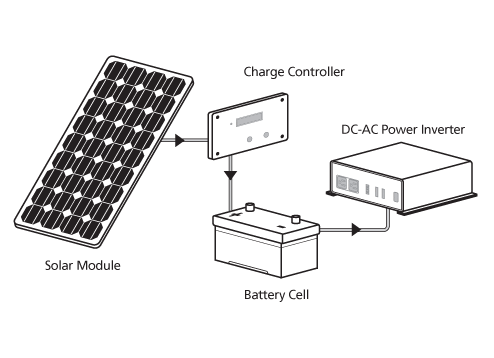
Above diagram shows a typical non-grid tied Photovoltaic (PV) System with its main components. It consists of a PV / Solar Panel (Module), Charge Controller, Batteries and Power Inverter. The PV / Solar Panel (Module) converts the solar light energy into DC electrical energy. The Charge Controller conditions the DC electrical voltage and current produced by the PV / Solar Panel (Module) to charge a battery. The battery stores the DC electrical energy so that it can be used when there is no solar energy available (night time, cloudy days etc). DC loads can be powered directly from the PV / Solar Panel (Module) / Battery. The inverter converts the DC power produced by the PV / Solar Panel (Module) / stored in the battery into AC power to enable powering of AC loads.
Grid-tied PV / Solar System
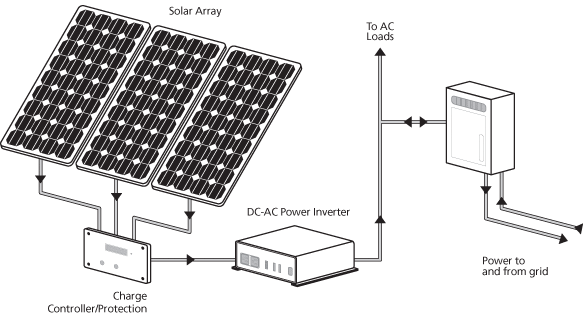
Above diagram shows a Grid-tied PV / Solar System. In this system, the Solar Panels (Modules) / Arrays directly feed to an inverter and the inverter is connected to an Electricity Transmission and Distribution System (referred to as the Electricity Grid) such that the system can draw on the Grid’s reserve capacity in times of need, and feed electricity back into the Grid during times of excess production. In order to safely transmit electricity to your loads and to comply with your power provider’s grid-connection requirements, you may need the following additional items:
- Power conditioning equipment
- Safety equipment
- Meters and instrumentation
Q: What are solar (PV) cell modules and arrays?
The basic element of a PV System is the photovoltaic (PV) cell, also called a Solar Cell. An example of a PV / Solar Cell made of Mono-crystalline Silicon is shown below. This single PV / Solar Cell is like a square but with its four corners missing (it is made this way!).
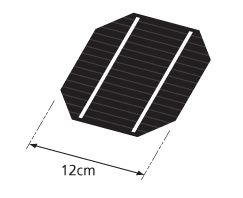
Theory Behind Operation of a PV/Solar Cell
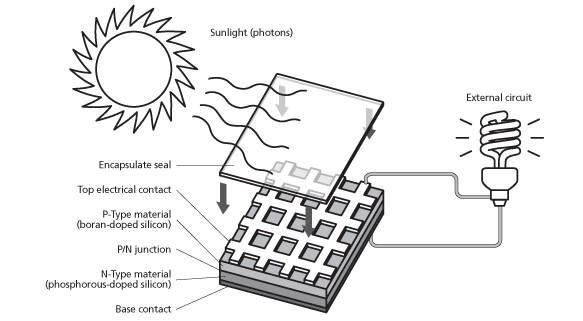
A PV / Solar Cell is a semiconductor device that can convert solar energy into DC electricity through the Photovoltaic Effect -conversion of solar light energy into electrical energy. When light shines on a PV / Solar Cell, it may be reflected, absorbed, or passes right through. But only the absorbed light generates electricity.
PV Module / Panel and PV Array
To increase their utility, a number of individual PV cells are interconnected together in a sealed, weatherproof package called a Panel (Module). For example, a 12 V Panel (Module) will have 36 cells connected in series and a 24 V Panel (Module) will have 72 PV Cells connected in series
To achieve the desired voltage and current, Modules are wired in series and parallel into what is called a PV Array. The flexibility of the modular PV system allows designers to create solar power systems that can meet a wide variety of electrical needs. Below is a schematic of a PV cell, Panel (Module) and Array.
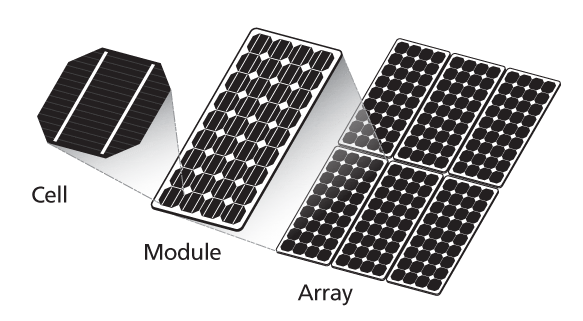
The cells are very thin and fragile so they are sandwiched between a transparent front sheet, usually glass, and a backing sheet, usually glass or a type of tough plastic. This protects them from breakage and from the weather. An aluminum frame is fitted around the module to enable easy fixing to a support structure. The picture below shows a small part of a Module with cells in it. It has a glass front, a backing plate and a frame around it.
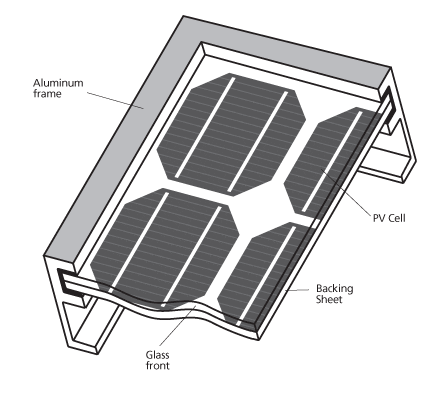
Bypass Diodes
As mentioned, PV / Solar cells are wired in series and in parallel to form a PV / Solar Panel (Module). The number of series cells indicates the voltage of the Panel (Module), whereas the number of parallel cells indicates the current. If many cells are connected in series, shading of individual cells can lead to the destruction of the shaded cell or of the lamination material, so the Panel (Module) may blister and burst. To avoid such an operational condition, Bypass Diodes are connected anti-parallel to the solar cells as in the diagram below. As a consequence, larger voltage differences cannot arise in the reverse-current direction of the solar cells. In practice, it is sufficient to connect one bypass diode for every 15-20 cells. Bypass diodes also allow current to flow through the PV module when it is partially shaded, even if at a reduced voltage and power. Bypass diodes do not cause any losses, because under normal operation, current does not flow through them.
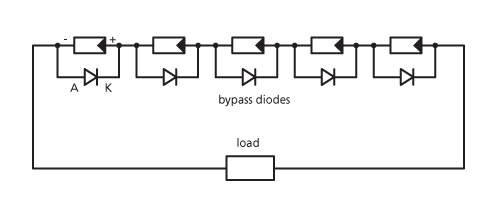
Q: What are Current, Voltage and Power Curves of a Solar (PV) Panel?
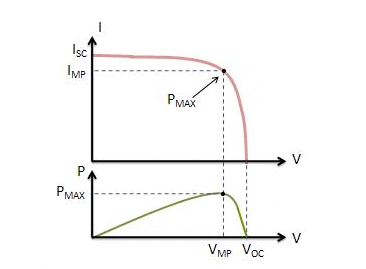
A Current (I) versus Voltage (V) Curve of a PV / Solar Module shows the possible combinations of its current and voltage outputs. A typical I-V curve for a 12 V Module is shown above.
The power in a DC electrical circuit is the product of the voltage and the current. Mathematically,
Power (P) in Watts (W) = The Current (I) in Amperes (A) X the Voltage (V) in Volts (V) i.e. W = V X A
A Solar (PV) Cell or a Panel / Module produces its maximum current when there is no resistance in the circuit, i.e. when there is a short circuit between its Positive and Negative terminals. This maximum current is known as the Short Circuit Current and is abbreviated as Isc. When the Cell / Panel (Module) is shorted, the voltage in the circuit is zero.
Conversely, the maximum voltage occurs when there is a break in the circuit. This is called the Open Circuit Voltage (Voc). Under this condition, the resistance is infinitely high and there is no current, since the circuit is incomplete. Typical value of the open-circuit voltage is located about 0.5 -0.6 V for Crystalline Cells and 0.6 -0.9 V for Amorphous Cells. These two extremes in load resistance, and the whole range of conditions in between them, are depicted on the I-V Curve. Current, expressed in Amps, is on the vertical Y-axis. Voltage, in Volts, is on the horizontal X-axis.
Maximum Power Point and Rated Power of Solar (PV) Panel
There is a point on the knee of the I-V Curve where the maximum power output is located and this point is called the Maximum Power Point (MPP). The voltage and current at this Maximum Power Point are designated as Vmp and Imp.
The values of Vmp and Imp can be estimated from Voc and Isc as follows: Vmp = (0.75 to 0.9) Voc Imp = (0.85 to 0.95) Isc.
The rated power of the PV / Solar Module in Watts (Pmax) is derived from the above values of voltage Vmp and current Imp at this Maximum Power Point (MPP):
Rated power in Watts, Pmax = Vmp x Imp
Example of I-V Curve and Ratings of a 12 V Solar (PV) Panel
This Maximum Power Point in the example curve given above is where Vmp is 17 Volts, and the current Imp is 2.5 amps. Therefore, the rated or the maximum power Wmax in watts is 17 Volts times 2.5 Amps, or 42.5 Watts.
Standard Test Conditions (STC) for Specifying PV / Solar Modules
The I-V curve is also used to compare the performance of PV / Solar Modules. The curve is, therefore generated based on the performance under Standard Test Conditions (STC) of sunlight and device temperature of 25°C. It assumes there is no shading on the device. Standard sunlight conditions on a clear day are assumed to be 1,000 Watts of solar energy per square meter (1000 W/m2 or 1 kW/m2). This is sometimes called one sun, or a peak sun. Less than one sun will reduce the current output of the PV device by a proportional amount. For example, if only one-half sun (500 W/m2) is available, the amount of output current is roughly cut in half.
Q: What are types of batteries for solar systems?
There are several different types of battery chemistry including liquid lead-acid, nickel-iron (NiFe), nickel-cadmium (NiCad), alkaline, and gel-cell. Batteries are either sealed or vented. Simply, there are only two principal types of batteries: starting and deep-cycle.
Starting Batteries
Starting batteries are designed for high cranking power, but not for deep cycling. Used as energy storage, they will not last long in a deep cycle application. Starting batteries use lots of thin plates to maximize the surface area of the battery. This allows very high starting current but lets the plates warp when the battery is cycled. This type of battery is not recommended for the storage of energy in hybrid system. However, they are recommended as starting battery for the back-up generator.
Deep Cycle Batteries
Deep cycle batteries are the type of battery best suited for use with inverters. The physical dimension of the plates is thicker and the active material that holds the charge is denser to increase cycle life. The deep cycle type of battery is designed to have the majority of their capacity used before being recharged. They are available in many sizes and in either non-sealed or sealed types.
Usual battery inverters are optimized for use with lead acid batteries that have a nominal voltage of 2.0 volts per cell. NiCad/NiFe batteries (also called alkaline batteries) have a nominal cell voltage of 1.2 volts per cell. The nominal voltage of a NiCad / NiFe battery bank can be made the same as a lead acid bank just by juggling the number of cells (10 cells for 12 volts, 20 cells for 24 volts and 40 cells for 48 volt systems). However, the NiCad/NiFe battery bank must be charged to a higher voltage to fully recharge and will drop to a lower voltage during discharging compared to a similarly sized lead acid type battery.
Q: What are some requirements for solar batteries?
Typical requirements for the battery to be used in long term storage are:
- low specific kWh-cost, i.e. the stored kWh during the whole life of the battery
- long lifetime
- high overall efficiency
- very low self-discharge
- low maintenance cost
- easy installation and operation
- high power
Specific kWh-cost
Usually it refers to a sum of investment and operation costs of the battery divided by the stored kWh (kWh) during its whole life. This cost is thus influenced by the battery’s lifetime.
Lifetime
The lifetime of the battery should be long, especially in order to keep the specific kWh-cost and the installation cost low, particularly in remote areas.
Overall efficiency
nE = nI n nV
The battery will usually need more charge than was taken out to fill it back up to its starting point. Typical average efficiencies are 80 to 85 % for stand-alone PV systems.
The voltage efficiency is determined by the average discharge voltage (VD) and average charging voltage (VC). VC is lower than VD particularly by internal resistance of the battery.
nV = VD / VC
The overall efficiency should be as high as possible, to be able to pass the biggest proportion of the energy in the battery, which is generated by the PV generator.
Self-discharge
The battery discharges itself even without load connected. This effect is caused by secondary reactions at its electrodes and proceeds faster with higher temperature or in older batteries. Thermodynamic instability of the active materials and electrolytes as well as internal- and external short-circuits lead to capacity losses, which are defined as self-discharge. This loss should be small, particularly in respect of annual storage.
Maintenance cost
The maintenance, e.g. water refilling in case of lead-acid batteries, should be kept as low as possible.
Power
In special cases, a battery must be highly loadable for a short time, e.g. at the start of diesel generators or in case of momentary power extension of PV systems. There are many types of batteries potentially available for use in stand-alone PV systems. Useful data of available batteries given in Table 1 shows approximated values and are provided as a guideline.
Table 1. Comparison between selection criteria of available batteries
| Type | Cycle life until 80%, DOD | Efficiency | Temp. range, °C | |
| Lead Acid | 500 – 1500 | 80 | -15° – .+50°C | |
| NiCd | 1500 – 3000 | 71 | – 40° – +45°C | |
| NiFe | 3000 | 55 | 0 – +40°C |
Since many values are dependent on charge and discharge conditions, they have not been standardized for PV applications and for test purposes until now. Therefore, the comparison between batteries and selection of the most suitable one for each application are not easy. Due to particular operating conditions with PV applications in practical operation, the cycle life given by manufacturer (and in Table 1) for cycling load can be reduced more than half.
According to Table 1 above, it follows that in most cases the lead-acid batteries would be the best choices for PV applications. The selection of suitable choices should be based on specific application.
Q: What are characteristics of lead acid batteries?
A basic equivalent circuit of the lead-acid battery is modeled by a voltage source with an equilibrium voltage (VE) in series with an internal resistor (Rin)(see below). It must be noted here that this configuration can describe only a current state because the magnitude of VE and Rin are not actually constant, but is function of many parameters such as state of charge (SOC), temperature, current density, and aging of the battery.
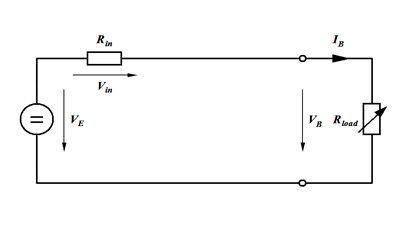
Furthermore, it is to consider that these parameters depend also on the current direction (charging or discharge). When the battery were at rest or under open-circuit condition VB = VE. When current is drawn from the battery, the voltage will be lower than VE. When current is flowing into the battery, the terminal voltage will be higher than VE.
Higher discharge current results in reduction of the terminal voltage. Therefore, to specify the state of the battery by the battery voltage, discharge current should be also measured.
In case of discharge, the minimum voltage level acceptable for a lead-acid battery is defined as discharge voltage threshold. Falling below this threshold is called deep discharge, with which the battery may suffer damage. In case that the battery is left longer after deep discharge, lead of the support structure is converted to lead-sulphate in rough-crystalline form, which during charging can be only bad or cannot be converted again anymore. As a result, the battery loses a part of its storage capacity; besides loss of support structure arises as well.
In practice, harmful deep discharge is to be prevented: the loads will be compulsory disconnected from battery as soon as the discharge voltage threshold is reached i.e. with the help of a so-called deep discharge protection (DDP). This threshold is basically given in the data sheets by the manufacturer for different discharge currents. Preferably, the value of this threshold should depend on the discharge current. The relation between the discharge current and the voltage during discharge for the lead-acid battery is presented below.
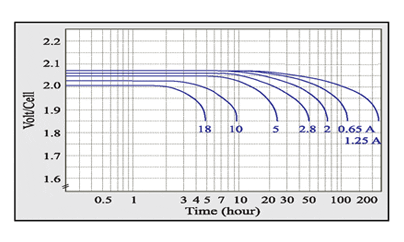
The above graph shows the discharge profile of a typical battery type at several constant current rates. The typical end-of-discharge voltage at these discharge rates can also be noticed where the voltage starts to drop steeply. Moreover, the end-of-discharge voltage varies between 1.75-1.9 V, depending on the battery type and the discharge current. Higher service capacity is obtained at the lower discharge rates. At higher discharge rates, the electrolyte in the pore structure of the plate becomes depleted, and it cannot diffuse rapidly enough to maintain the cell voltage. However, intermittent discharge, which allows time for electrolyte diffusion will improve the performance under high discharge rates.
Gassing
With 2.3 V and 2.4 V, gas is developed at the electrodes in the battery, by which the water is decomposed into hydrogen and oxygen. Both gases mix together in the battery providing detonating gas (explosive!) and escape through ventilation opening in the vent plug. With the gassing, the battery loses also water, which must be refilled according to maintenance within regular intervals. The gas is the unwelcome secondary reaction of the chemical conversion during charging because current is consumed for the electrolysis and therefore the storage efficiency of the battery is made worse unnecessarily. After the gassing voltage is exceeded, voltage stays approximately constant. The whole charging current during this period results in H2 and O2, which is defined as loss.
Freezing of electrolyte
For applications with low ambient temperature, the lead-acid battery must also be protected against freezing of electrolyte. The risk of freezing depends on the state of charge.
The graph below illustrates the freezing limit as a function of the state of charge.
Cycle life of lead acid batteries
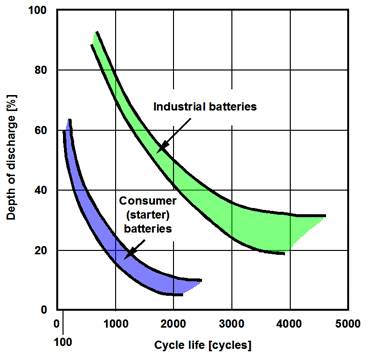
Q: How a RV solar system works?
Download a schematic of how a RV solar system works with Samlex products and your RV.













